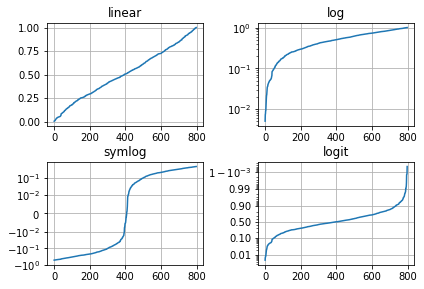控制线条的属性
- linewidth 线宽
- dash style 折角样式
- antialiased 反锯齿
- ...
line, = plt.plot([1,2,3], [2,3,7],'-', linewidth=2.0)
line.set_antialiased(False) # 关闭反锯齿
plt.show()
设置线条属性:setp()
lines = plt.plot([1,2,3], [2,3,7])
# 关键字参数
plt.setp(lines, color='r', linewidth=2.0)
# 或 MATLAB 样式的 '键值对'
plt.setp(lines, 'color', 'r', 'linewidth', 2.0)
plt.show()
可设置的所有属性:
| properties | values |
|---|---|
| alpha | float |
| animated | [True | False] |
| antialiased or aa | [True | False] |
| clip_box | a matplotlib.transform.Bbox instance |
| clip_on | [True | False] |
| clip_path | a Path instance and a Transform instance, a Patch |
| color or c | any matplotlib color |
| contains | the hit testing function |
| dash_capstyle | ['butt' | 'round' | 'projecting'] |
| dash_joinstyle | ['miter' | 'round' | 'bevel'] |
| dashes | sequence of on/off ink in points |
| data | (np.array xdata, np.array ydata) |
| figure | a matplotlib.figure.Figure instance |
| label | any string |
| linestyle or ls | [ '-' | '--' | '-.' | ':' | 'steps' | …] |
| linewidth or lw | float value in points |
| lod | [True | False] |
| marker | [ '+' | ',' | '.' | '1' | '2' | '3' | '4' ] |
| markeredgecolor or mec | any matplotlib color |
| markeredgewidth or mew | float value in points |
| markerfacecolor or mfc | any matplotlib color |
| markersize or ms | float |
| markevery | [ None | integer | (startind, stride) ] |
| picker | used in interactive line selection |
| pickradius | the line pick selection radius |
| solid_capstyle | ['butt' | 'round' | 'projecting'] |
| solid_joinstyle | ['miter' | 'round' | 'bevel'] |
| transform | a matplotlib.transforms.Transform instance |
| visible | [True | False] |
| xdata | np.array |
| ydata | np.array |
| zorder | any number |
获取参数列表:
plt.setp(lines)
多个图像区域(figures)和轴(axes)下作图
def f(t):
return np.exp(-t) * np.cos(2*np.pi*t)
t1 = np.arange(0.0, 5.0, 0.1)
t2 = np.arange(0.0, 5.0, 0.02)
plt.figure(1)
plt.subplot(211)
plt.plot(t1, f(t1), 'bo', t2, f(t2), 'k')
plt.subplot(212)
plt.plot(t2, np.cos(2*np.pi*t2), 'r--')
plt.show()
figure()函数是可选的,因为 figure(1)会默认被执行
如果不指定 subplot(), subplot(111)也是默认的
subplot()包括 行号,列号,图号,如果 行号*列号<10
三个参数可以写在一个参数里
所以 subplot(111)就相当于subplot(1,1,1)
plt.figure(1)
###
plt.subplot(211)
plt.plot([1, 2, 3])
plt.subplot(212)
plt.plot([4, 5, 6])
plt.figure(2)
###
plt.plot([4, 5, 6])
plt.figure(1)
###
plt.subplot(211)
plt.title('Easy as 1, 2, 3')
plt.show()
多个figures的情况下,可以通过figure()选择不同的figure
通过subplot()选择不同的plot
cla() 清除当前plot
clf()清除当前figure
text()
plt.plot([1,5],[1,5])
plt.text(3,2.5,'y=x')
plt.show()
xlabel(), ylabel() and title()分别在固定的地方标示文本
plt.plot([1,5],[1,5],'b')
t = plt.text(3,2.5,'y=x')
plt.setp(t,'color','red')
plt.show()
result:
文本也可以使用
setp() 来改变其属性
文本中使用数学表达式
plt.text(.5, .5, r'$\sigma_i=15$')
plt.show()
matplotlib 内建数学表达式: Writing mathematical expressions.
annotate()
plt.annotate('(0,0)', xy=(0, 0), xytext=(1, 1),
arrowprops=dict(facecolor='black', shrink=0.05),)
plt.ylim(0, 2)
plt.xlim(0, 2)
plt.show()
产生正态分布随机数,画直线, log函数, 对称log函数,分对数函数
from matplotlib.ticker import NullFormatter
np.random.seed(19680801)
y = np.random.normal(loc=0.5, scale=0.4, size=1000)
y = y[(y > 0) & (y < 1)]
y.sort()
x = np.arange(len(y))
# linear
plt.subplot(221)
plt.plot(x, y)
plt.yscale('linear')
plt.title('linear')
plt.grid(True)
# log
plt.subplot(222)
plt.plot(x, y)
plt.yscale('log')
plt.title('log')
plt.grid(True)
# symmetric log
plt.subplot(223)
plt.plot(x, y - y.mean())
plt.yscale('symlog', linthreshy=0.01)
plt.title('symlog')
plt.grid(True)
# logit
plt.subplot(224)
plt.plot(x, y)
plt.yscale('logit')
plt.title('logit')
plt.grid(True)
plt.gca().yaxis.set_minor_formatter(NullFormatter())
plt.subplots_adjust(top=0.92, bottom=0.08, left=0.10, right=0.95, hspace=0.35,
wspace=0.35)
plt.show()
欢迎关注我的博客Vagitus – Pythonista









